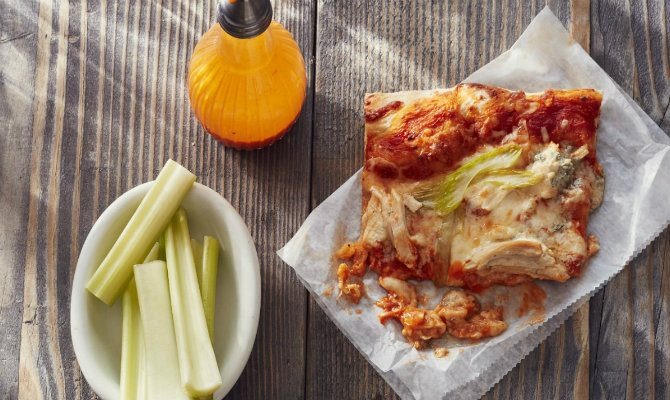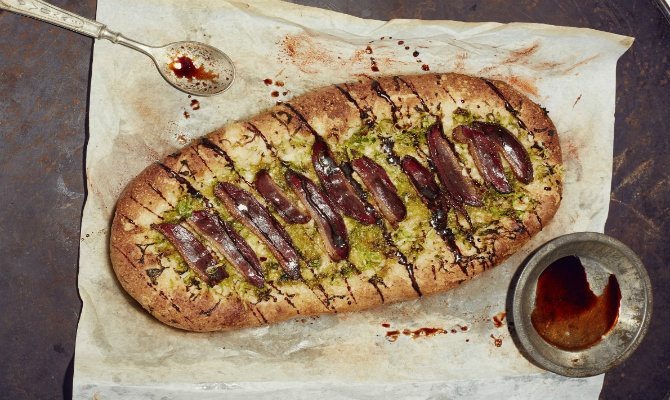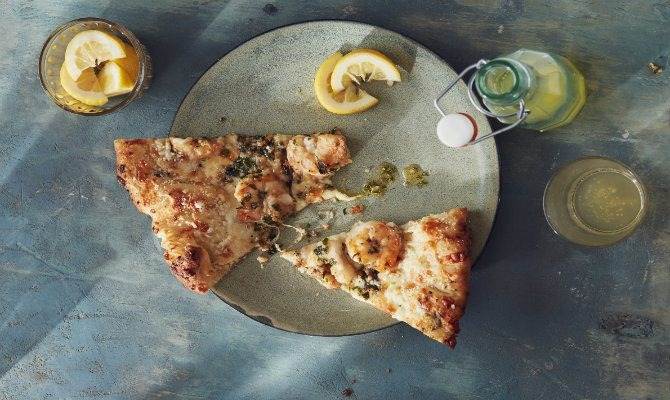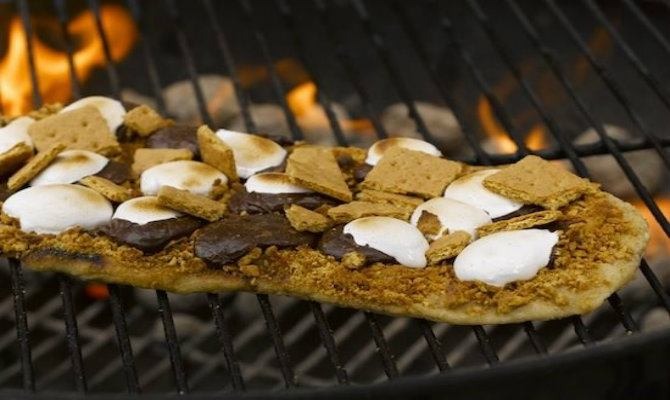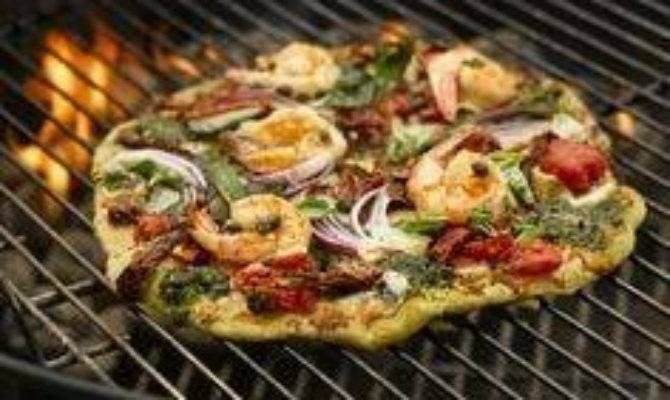A Slice Of Americana: An Interview With Craig Priebe Of 'The United States Of Pizza'
We may receive a commission on purchases made from links.
"I am kind of sharing the Americana now, instead of just inventing stuff," says Craig Priebe. For roughly five years, the Chicago chef tracked down the best pizzas across the United States searching for unlikely flavor combinations, unusual doughs, and overlooked techniques, all of which he now divulges in his cookbook The United States of Pizza. This talented chef with a penchant for grilled pizzas (formerly of C.K.'s Grilled Pizza in Atlanta) was even called a "pizza miracle worker" by Chicago Magazine — quite the compliment coming from a city that prides itself on its own deep-dish-style pizzas.
With his second cookbook, Priebe takes on the role of pizza enthusiast, storyteller, and food historian, capturing the oral histories from the owners of famed pizzerias across the country and packaging them with his own recipes inspired by those experiences. He seamlessly weaves his easy-going appetite for storytelling with sophisticated cooking techniques broken down for the average cook.
Priebe pays homage to the many cultures that blend together in this country through the narrowed lens of pizza. Representing the far reaches of the United States, these recipes deliver a taste of Americana to readers. Priebe places the people that inspired these pizza recipes front and center — from the proprietors of well-known pizzerias in bustling cities, like Roberta's Pizza in Brooklyn, New York, to the folks behind treasures tucked away in more isolated parts of the country, like Red Fox Pizza in Jackson, New Hampshire.
We had the opportunity to talk with Priebe to find out a little bit more about his passion for pizza and the people he met along his journey.
The Daily Meal: This is your second book about pizza. What are the differences between how you approached this book and how you approached the previous one?
Craig Priebe: Well, this book is really completely different than the first. My first book was based on my restaurant that I had for eight years, which I no longer have. All of the recipes in that book are about grilled pizza, and were award-winning recipes that we made at the restaurant. The pizza from the restaurant and my grilled pizza cookbook are considerably different from the pizza I found across the United States. There are very few grilled pizzas in the United States, and I put the most famous one, from George Germon at Al Forno, in the book. He started the whole grilled pizza thing in the United States 20 years ago.
This book was inspired by not only the restaurants and pizzerias we see across the United States, but also by the people and why they chose to innovate pizza in different ways. Those stories were really inspiring to me, and the way pizza changed as you travel across the nation really intrigued me, so I knew I wanted to write about that.
Can you tell us a little bit about your philosophy on food and cooking?
First off, you have to start with top quality ingredients. It is the most important thing; you can't take any shortcut around good ingredients. I like to take the simplest, most direct approach to get to where I want to be. You don't need to do a lot to great ingredients.
[pullquote:left]There are some steps that can be made complicated in the world of pizza that don't need to be. In The United States of Pizza, I really tried to make my recipes user-friendly and simple. I wanted the reader to have a direct path to a great result. I do like to make things simple with incredible ingredients that let the food speak for itself. The different combinations allow flavors to bounce off each other and complement one another. I like to create dishes and pizzas where the flavors almost come to life with the featured ingredients at the center of the plate, or in this case pizza. You can see the ingredients. I don't like to make ingredients too small where you can't see where [the flavor] is coming from. What you want is that mosaic of ingredients on top of the pizza.
I think everyone has some kind of attachment to a food or a cuisine. How did you find your way to pizza and to cooking in general?
I was raised in a wonderful Tuscan-Italian family. There was so much cooking, so much food, and so much love of food and family when I was growing up. My grandmother, who passed away last April, was 102 years old when she died; she was an incredible Italian cook. I remember standing next to her watching her make polenta, ravioli, braciole, foods that she really liked to cook — and pizzas. It was weird — she was a Tuscan grandmother, but she made Sicilian-style pizza. I'm not sure why she did that, but she loved it.
I grew up cooking. When I was in high school, I was cooking in restaurants. After high school, I ran to the culinary college Triton College. I did an apprenticeship with the American Culinary Federation, so I really wrapped my life around food, cooking, and the hospitality industry.
I was inspired by George Germon and his restaurant Al Forno. Many years ago I was interested in his book Cocina Simpatica. Everything in that book inspired me to start making grilled pizzas, and I thought grilled pizza was the most ethereal thing I could make at that time. It still is just phenomenal.
I have really opened my eyes to pizzas across the country over these past five years I have been studying it. Before, I was almost a grilled pizza snob; I thought it was the best kind of pizza to make. But after making all of these pizzas in the United States, I really have a love for some of the Sicilian-style pies, the sourdoughs, and the flavors that I have seen across the nation, as well as the pizza recipes that I have made up.
I perfected the dough recipes; because I had to start there, making sure each style of dough was No. 1 first. Incidentally, that's my philosophy on pizza — the dough is No. 1. And then, with everything else, the dough has to be able to support it and the flavors have to be in balance. The dough has to be tender and delicious, and it has to have the right chew, the right pull — the right consistency. Even though these ingredients are very simple, I enjoy simple ingredients with fine technique.
How do your earlier experiences with food differ from what you experience now?
I am really interested in food across America now. The way I used to approach pizzas, I wanted to invoke certain places or cultures or moments. [For instance,] I created an "Oregon Trail" pizza, which was built on a baking soda-cornmeal crust because during the days of the Oregon Trail that is all they used. Because they traveled across the United States, they carried with them brined pork bellies in heavily salted water, which they would eat for probably two years. Then, once they crossed the United States, they had oysters, which were a good source of food. This is how I came to this smoked pork belly, oyster, and marionberry jam pizza. It is all these components that make it so cool; I have captured the history, the culture, and the story all in one pizza. I created many of the pizzas in my first book like that.
And how does that influence the recipes in this book?
Now that I have created this book, the difference is that I am inspired by everyone else's stories, from their lives and from the pizzas they serve in their pizzerias. I was inspired by actual things that were already created, whereas I used to create something from my imagination or history or culture. Now, in The United States of Pizza, I am really emulating great pizzas from across the country. They are my recipes, and in many cases, I take a few chef terms and I give it my special touch. I love giving the credit to these places that inspired these pizzas, and I love talking about these people who created so many amazing recipes. I am kind of sharing the Americana now, instead of just inventing stuff. It's kind of fun, and I love this stuff.
What's the takeaway for readers? What do you hope they'll get from this book?
They are going to get that the United States is not so much of a melting pot as it is one giant pie, bubbling over with many different ingredients. We have taken a gift from Italy, where they love to create pizza with strong traditions, and we have innovated over the past hundred years. The innovation of pizza has just gone crazy bizarre. We have pizzas that you have never heard of in different niches of the country, and I like to bring those ideas out and start talking about them. There are Detroit red stripe pizzas, Pennsylvania pierogi pizza, and deep-dish Reuben pies. There are so many things — the American spirit, the innovation, and the entrepreneurial spirit of so many people — that have led to the creation of these incredible pizzas across the United States.
Now, people can see these pizzas from across the United States, and they can make them in their home oven. These recipes are designed with great technique, but you can make them in any home oven. I cooked all these pizzas in simple home ovens.
What is one of your favorite anecdotes about pizza that you learned while researching for this cookbook?
I like "Uff da." It's a Norwegian expression that means "more of everything." It is from one of the pizzerias in Minneapolis. They like their uff da there. It is just more fun, and it's just a big, vibrant part of life.
Anything else you want to tell us about the book?
I think that there are amazing stories, and [the book] is a slice of Americana, a travel guide, and [a collection of] great stories about great people who have innovated pizza and made [pizza] what it is today from coast to coast.
There is a pizzeria guide in the back, so if you want to visit any of these pizzerias, you can find them there. The recipes are simple, and they are built for your home kitchen. You will have great results, and also learn a lot about pizza in the United States.
Outside of the food world, what influences your ideas on food the most?
Culture. In each region there are histories, and culture, and these people's stories — that is what influences me. I like to hear about stories like where somebody wanted to move across the United States to build a pizzeria. These two guys wanted to move from New York to Nevada, and they have nothing but this really simple oven, and they open this pizzeria, and the restaurant is still there like 80 years later. That is the kind of thing that is really inspirational. There are people like this guy who started making pizza in a closet in the back of a dusty old grocery store in Arizona, and now he is known coast to coast as a visionary pizza maker — Chris Bianco. He is one of the most inspired and visionary pizza makers, and he started in a closet. I think that is just one of the coolest things.
What is your all-time favorite pizza?
My favorite pizza of all time is one that I made in my kitchen at home. I really have made remarkable pizzas at home (this one isn't very exciting), but I would say a Margherita pizza is one of my favorite pizzas of all time. The base is a simple beautiful thing, and when you make it with a sourdough crust it takes those simple ingredients to a whole new level. I think that is the kind of pizza I like the best. I know there are a lot of good pizzerias in the city and everywhere across the nation, but I really enjoy making pizza at home, and that is why I made this book — so that everyone could get that same bug.
The United States of Pizza is on sale September 22, 2015
Want to try a recipe?
Buffalo Chicken Pizza: Big Time Pizza
Rest assured that people visiting Mount Rushmore in spring, summer, or fall can get flavorful pizza at Big Time. Thousands of campers, hikers, and vacationers come to this scenic area each year, expecting to find great beauty and tranquility in nature. They are pleasantly surprised to find great pizza, too, among the rocky cliffs and mountainous terrain. Big Time means big flavor, as in this spicy Buffalo Chicken Pizza, which just might melt the ice off that South Dakota winter. In the meantime, you can enjoy it from the comfort of your own kitchen. — Craig Priebe
Darkwing Duck Pizza: Roberta’s Pizza
I had never come across a duck pizza until I found Roberta's. This pie features duck prosciutto, Brussels sprouts, and Chandoka, a Wisconsin cheese made from goat and cow's milk. — Craig Priebe
For the Darkwing Duck Pizza recipe, click here.
Shrimp Scampi Pizza: Santarpio’s Pizza
Santarpio's is an East Coast institution, and has been serving Bostonians since 1903. The place is filled with thick Boston accents and Frank Sinatra on the jukebox. The pie features jumbo shrimp slathered in rich garlic butter on a bed of fresh mozzarella. Shrimp scampi is an Italian-American dish in which shrimp are baked in garlic butter and nestled under a bed of breadcrumbs and cheese. It's all that and more on a pizza. — Craig Priebe
S’more Pizza
One summer night I was grilling pizza over a big campfire in my backyard. I realized that in my pantry I had all the makings for s'mores, the classic campfire dessert of graham crackers, melted chocolate, and caramelized marshmallows. I put the components together for this s'more pizza, and my kids went wild. A graham cracker crust goes right on top of the crisp pizza crust, then it's piled with hot fudge and gooey marshmallow cream, which is sold at most grocery stores. Everyone will want s'more. — Craig Priebe
Gamberini Pizza
This grilled pizza is perfect for your next summer party. Topped with sautéed shrimp, pesto, and tomatoes, it won't leave your guests disappointed.
Verduran Pizza
Verdure is Italian for green, and this mostly green pizza is inspired by that word. If you don't have the exact vegetables listed here, substitute others such as artichoke hearts, zucchini, or Portobello mushrooms. — Craig Priebe
For the Verduran Pizza recipe, click here.
Other cookbooks about pizza we like.
The Pizza Bible
By Tony Gemignani
Tony Gemignani, an 11-time world pizza champion, sets out to do for pizza what The Cake Bible did for cakes. This cookbook tackles all of the nuances of making pizza from dough to plate.
Grilled Pizza the Right Way
By John Delpha
John Delpha learned from the only man you go to if you want serious pizza grilling technique: George Germon of Al Forno in Providence, Rhode Island. This comprehensive book guides the reader through the sometimes-complicated steps with ease.
Click here for more recipes from cookbooks.
Angela Carlos is the Cook Editor at The Daily Meal. Find her on Twitter and tweet @angelaccarlos.
